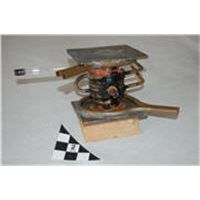Online Collections at UoB - Objects
ID number: BIRRC-P0892
Institution: Research and Cultural Collections
Named collection: Historic Physics Collection
Artist / Maker: Physics Department Workshop
Title / Object name: Cavity Magnetron - A replica of original
Object type: Cavity magnetron
Place made: Europe: United Kingdom, West Midlands, Birmingham
Date made: 1989 (copy of original made 1940)
Materials: Copper and glass
Measurements: 26 x 21 x 11cm
|

|
The cavity magnetron was invented in the Department of Physics at the University of Birmingham in 1940. It was used to generate microwave radiation of centimetre wavelengths for use in radar, and proved invaluable to the allies in World War II. The first magnetron was operated on 21 February 1940 by John Randall and Harry Boot in a team led by Professor Mark Oliphant. Within months magnetrons were in commercial production and used to detect ships and aircraft.
The original magnetron is in the Science Museum in London, and this item is a replica made for the 50th Anniversary.
The core is a water-cooled copper anode block containing a ring of six parallel cylindrical cavities (approx 1.1 cm in diameter) surrounding a central larger cavity. The whole is evacuated with an external pump and mounted in a strong magnetic field along its axis. In the centre is a heated cathode that emits electrons. These electrons move in circular paths in the central cavity and excite resonant electromagnetic oscillations in the surrounding cavities. Waves can be picked up by an electrode in one of these cavities and transmitted down the projecting output lead. The wavelength was 9.8 cm and the CW output was estimated to be 400 W with an anode-cathode p.d. of 16 kV and magnetic field of 0.1 T.
Notes: S. Cockburn and D. Ellyard, “Oliphant”, Axiom Books, Adelaide, 1981 Chap. 7
H. A. A. Boot and J. T. Randall, Historical notes on the cavity magnetron, IEEE Transactions on Electron Devices 23, p724.
|
| << Viewing Record 171 of 1323 >> |